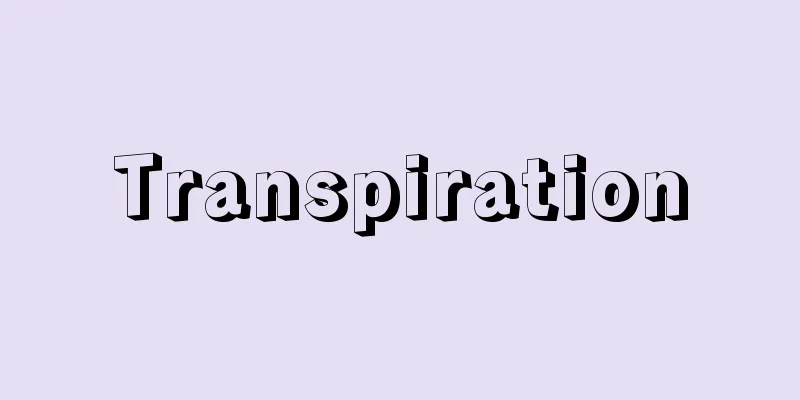Transpiration

|
Transpiration is the phenomenon in which water in a plant becomes water vapor and is released into the atmosphere from the surface of the plant body. It is also called transpiration. It differs from simple evaporation in that plants regulate the release of water. In particular, transpiration through stomata is regulated by the opening and closing movement of guard cells (cells that create stomata). Some of the water absorbed by the roots is used to maintain the turgor pressure of the cells and for metabolism, but most is lost through transpiration. Transpiration mainly takes place in the leaves. The surface of the leaves is covered with a hard layer called the cuticle, so the stomata are the main site of transpiration. If the stomata were completely closed, transpiration should not occur, but in fact, transpiration also occurs through the cuticle layer on the surface of the leaves. Transpiration from the stomata is called stomatal transpiration, and transpiration through the cuticle layer is called cuticular transpiration. The ratio of the two varies depending on the type of plant, but stomatal transpiration usually accounts for the majority. Since stomata are the site of gas exchange in plants, transpiration is also affected by internal and external conditions. Of the external conditions, moisture has the greatest effect, and when soil moisture decreases, stomata close and transpiration is suppressed. This regulation of transpiration by opening and closing stomata is carried out by plant hormones, and it is believed that cytokinins are what convey the decrease in moisture in the soil to the leaves. Cytokinin has the function of opening stomata, but when soil moisture decreases, the amount of cytokinin transported from the roots to the aboveground parts decreases, and accordingly the amount of cytokinin in the leaves decreases, causing the stomata to close and suppressing transpiration. Also, abscisic acid senses the decrease in moisture content in the mesophyll cells and conveys this information from the mesophyll cells to the guard cells; abscisic acid in the leaves increases when moisture decreases, causing the stomata to close. In addition, the opening and closing of stomata is also influenced by light and carbon dioxide concentration. In other words, stomata open in bright places and close when it is dark, close when carbon dioxide concentration is high and open when it is low, etc. Transpiration is the driving force behind the rise of water in plants. Within a plant, water is connected from the tip of the leaf to the end of the root through xylem vessels, and when transpiration is active, water will rise continuously unless water absorption is stopped. At the same time, nutrient salts are also transported. It is said that transpiration becomes active when leaves are exposed to strong light because the evaporation of water removes the heat of vaporization, preventing the leaves from overheating. However, desert plants actually close their stomata during the day to reduce transpiration. [Seiichi Yoshida] "Learn Soil Physics on the Computer: Fundamentals of Natural Environment Management" by Gaylon S. Campbell, translated by Nakano Masashi (1987, Kajima Publishing Co.)" ▽ "Rice Cultivation Encyclopedia 2: Growth, Physiology and Ecology" (1990), published and edited by the Rural Culture Association" ▽ "Ecology of Alpine Plants" by Masuzawa Takehiro (1997, University of Tokyo Press)" ▽ "Illustrated Fun Science Play: Biology Edition, edited by Yamazaki Taneyoshi and written by Fukushima Yoko (1999, Toyo Publishing)" ▽ "The Complete Guide to Nutrient Solution Cultivation" by Yamazaki Kan'ya (2000, Hakuyusha)" ▽ "Plant Water Physiology" by Nonami Hiroshi (2001, Youkendou)" [References] | | | | | |Source: Shogakukan Encyclopedia Nipponica About Encyclopedia Nipponica Information | Legend |
|
植物中の水が、水蒸気となって植物体の表面から大気中に放出される現象で、通発ともいう。単なる蒸発と異なるところは、植物が水の放出について調節を行う点であり、とくに気孔を通じての蒸散は、孔辺細胞(気孔をつくる細胞)の開閉運動によって調節されている。 根から吸収された水は、一部は細胞の膨圧の維持や代謝に用いられるが、大部分は蒸散によって失われる。蒸散の行われる場所は主として葉である。葉の表面はクチクラという硬い層で覆われているので、気孔がおもな蒸散の場となる。完全に気孔が閉じると蒸散が行われないはずであるが、実際には、葉の表面のクチクラ層を通っても蒸散が行われている。気孔からの蒸散を気孔蒸散、クチクラ層を通しての蒸散をクチクラ蒸散という。両者の割合は植物の種類によって異なるが、普通は気孔蒸散が大部分を占めている。気孔は植物のガス交換の場であるため、内的および外的条件によって蒸散も影響を受ける。外的条件のうち、水分による影響がもっとも大きく、土壌水分が低下すると気孔が閉じて蒸散は抑えられる。このような気孔の開閉による蒸散の調節は植物ホルモンによって行われ、土壌中の水分低下を葉に伝えているのはサイトカイニンであるとされている。サイトカイニンは気孔を開かせる働きをもつが、土壌水分が低下すると、根から地上部に運ばれるサイトカイニン量が減り、それに応じて葉の中のサイトカイニン量が低下して気孔が閉じ、蒸散が抑えられる。また、水分含量の低下を葉肉細胞で感知し、葉肉細胞から孔辺細胞へと情報を運んでいるのはアブシシン酸で、葉のアブシシン酸は水分が減ると増加し、気孔を閉じさせる。このほか、光や二酸化炭素濃度によっても気孔の開閉は左右される。つまり、気孔は明るいところで開き、暗くなると閉じ、二酸化炭素濃度が高いと閉じ、低くなると開くなどである。 蒸散は植物体における水の上昇の原動力となるものである。植物体内では、水は葉の先端から根の末端までが木部の道管を通ってつながっており、蒸散が盛んに行われている場合は、吸水が断たれない限り、連続して水は上昇する。このとき同時に栄養塩類の移動運搬も行われる。葉が強光にさらされると蒸散が盛んになるのは、水の蒸発によって気化熱を奪い、葉を過熱から防ぐためといわれる。しかし、砂漠の植物はかえって昼は気孔を閉じて蒸散を少なくしている。 [吉田精一] 『ゲイロン・S・キャンベル著、中野政詩訳『パソコンで学ぶ土の物理学――自然環境管理の基礎』(1987・鹿島出版会)』▽『農山漁村文化協会編・刊『稲作大百科2 生育 生理と生態』(1990)』▽『増沢武弘著『高山植物の生態学』(1997・東京大学出版会)』▽『山崎種吉監修、福嶋葉子著『図解 たのしい科学遊び 生物編』(1999・東陽出版)』▽『山崎肯哉著『養液栽培全編』(2000・博友社)』▽『野並浩著『植物水分生理学』(2001・養賢堂)』 [参照項目] | | | | | |出典 小学館 日本大百科全書(ニッポニカ)日本大百科全書(ニッポニカ)について 情報 | 凡例 |
Recommend
seven deadly sins
In Buddhism, sin is an act that goes against the ...
Gengenshu - Gengenshu
A medieval Shinto book. Eight volumes. It is said ...
The art of lovemaking - bochuujutsu (English spelling) fang-zhong-shu
A practical method for sexual intercourse in the b...
True View
1268-1341 (Bun'ei 5-Kokoku 2/Ryakuo 4) A Ji se...
Conwentz, H.
The origin of this idea is said to be in 1800, wh...
Chinese numerals - Kansuushi
...see table) and the use of Persian (and Arabic)...
Confinement - Confinement
A type of immediate coercion stipulated in the ol...
Jens - Walter Jens
German writer, critic, and literary scholar. He s...
《Islendingabók》(English spelling)
… He was from a distinguished family and was educ...
Mini-states
A ministate is a state with an extremely small ter...
Walpole, Sir Robert, 1st Earl of Orford
Born: 26 August 1676, Houghton Hall, Norfolkshire ...
Salt addict - Ento (English spelling) yan-tu; yen-t`u
In China, a group of people who smuggled salt unde...
Fernando VI
1713‐59 King of Spain. Reigned 1746-59. He appoint...
Limicola falcinellus; broad-billed sandpiper
Charadriiformes, Scolopacidae. Total length 15-18c...
Schubweise
…This term is used to describe the progression of...







![Missouri [river] - Missouri](/upload/images/67ccf18319e3e.webp)

